Community Tip - Learn all about PTC Community Badges. Engage with PTC and see how many you can earn! X
- Community
- Addtl Creo Products (View/Sketch/Illustrate/Layout/ Schematics and Creo Direct)
- Addtl Creo Products (View/Sketch/Illustrate/Layout/ Schematics and Creo Direct)
- Re: Mapped mesh and conflit with native Creo geome...
- Subscribe to RSS Feed
- Mark Topic as New
- Mark Topic as Read
- Float this Topic for Current User
- Bookmark
- Subscribe
- Mute
- Printer Friendly Page
Mapped mesh and conflit with native Creo geometry
- Mark as New
- Bookmark
- Subscribe
- Mute
- Subscribe to RSS Feed
- Permalink
- Notify Moderator
Mapped mesh and conflit with native Creo geometry
Hello all
As far I know, since beginning of Pro/E, a CAD volume has been always a “divided” surface. An extruded (or other construction) part will always have two faces that can be selected.
Usually – but not always – most of the time the CAD interprets it as a unique surface. Thus this is not a major problem.
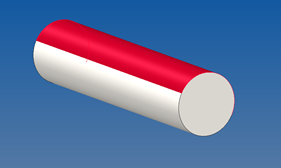
However I have some times meshing problems exactly in the interface of these surfaces - especially if it is located in a bad position in an assembly forming for example a sharp corner.
My current issue is that my mapped mesh is getting too complex due to this characteristic. I´m trying to create a mapped mesh in a contact region. However this native split is being considered inside Simulate and the consequence is that I have to mesh a more regions and even worst – to create more contact regions. I consider a good contact mesh a mesh that has common elements in both sides of the contact. This is usually possible only if the mapped mesh patter can match both sides of the contact geometry - as in the picture below when volumes in both sides were create to match the contact region. The problem is that Creo finds not 2 volumes in the cylinder but 4 - due to the native CAD split.

_ My question is if there is a way to “trick” Creo that it ignores these artificial regions created in the native mode and simple respect the volumes regions that I applied. To illustrate here is the cylinder model. To map the ring I need to map not 4 regions but 6 regions!
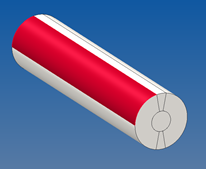

I guess that one can find a good approach for specific cases as the one above but the true is that this undesired split in the original CAD model can cause meshing issues and I´m thus looking for a way to merge the native surfaces - if this is the best approach, of course.
Thank you in advance for any feedback.
R. Rabe
- Labels:
-
Creo Illustrate
- Mark as New
- Bookmark
- Subscribe
- Mute
- Subscribe to RSS Feed
- Permalink
- Notify Moderator
- Mark as New
- Bookmark
- Subscribe
- Mute
- Subscribe to RSS Feed
- Permalink
- Notify Moderator
Thanks Paul
Indeed I have not included all the tries in the original message but basically focused on the main problem - the undesired face split and if there is a way to merge them.
I alreaedy used this approach (placing the native split in the region that has no contact). At least there was a way to mesh the contact region - for this case!
It is better but not free of drawback .
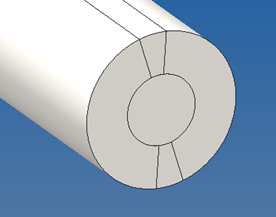
Now I ran into new problems in meshing the non-mapped volumes because the native split part was still causing problems.
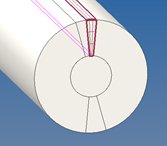
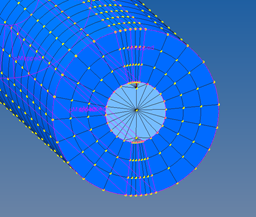
To try overcome some bad meshing problem I had to divide the cylinder in even smaller volumes. This was not only more complex but also created a lot of unnecessary elements in a region of less interest (the non-contact).
An additional negative point is that I have to mesh several of these cylinders with contact and each one would have12 volumes to apply mapped-mesh!

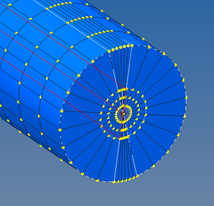
- Mark as New
- Bookmark
- Subscribe
- Mute
- Subscribe to RSS Feed
- Permalink
- Notify Moderator
Maybe a nice update.
Although you cannot avoid that Creo always split a part it is possible to “move it” to a more desired region just segmenting the original sketch.
The original cylinder was dived in the regions that will not have contact. The circle has now 4 controlled segments.

The same procedure when creating the "volume regions" inside Creo Simulate
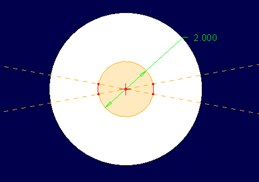
Now there is no extra regions caused by the native split. The result is thus an easier meshing with less steps (4 regions with mapped mesh).

To guarantee a symmetric meshing in the center a "hard curve control" autogem was included using an axial center line.
- Mark as New
- Bookmark
- Subscribe
- Mute
- Subscribe to RSS Feed
- Permalink
- Notify Moderator
Hi,
You wrote: "I consider a good contact mesh a mesh that has common elements in both sides of the contact"...
In simulate (p-system) it is not so, but h-system.
Regards
Paul
- Mark as New
- Bookmark
- Subscribe
- Mute
- Subscribe to RSS Feed
- Permalink
- Notify Moderator
Hi
In some simulations having contact I try to play with the mesh (as using mapped mesh) to try to reduce the solution time or better results around the contact area. Sometimes with good results but a lot of time with non-convergence at all - although the default (and nearly chaotic) mesh can reach! Still a lot to learn here.
Matching the mapped mesh in both sides of the contact would be for me similar what the option "create compatible mesh" would do in contact with the default mesh. So I though that it is a good way to start. I also saw this approach in some tutorials examples dealing with contact (as you may have already seem is some of the SAXSIM or PTC presentations)
Indeed with a p-system this should be irrelevant but benchmarking two approaches (compatible mesh or not) could show if there is any relevant difference.
I may try IF I finally get my model working with mapped mesh...
- Mark as New
- Bookmark
- Subscribe
- Mute
- Subscribe to RSS Feed
- Permalink
- Notify Moderator
Hi,
for contact:
Regards
Paul
- Mark as New
- Bookmark
- Subscribe
- Mute
- Subscribe to RSS Feed
- Permalink
- Notify Moderator
Indeed in some Creo Simulate courses (or even before, in WF) the instructor advised us that "generate compatible mesh" command could bring some problems during simulation - so it was better no use it (so why it is still there?)
I ran once the contact simulations with the option "split surface" unchecked and the result was that the parts in contact behaved the same as "bonded" with some plus like the possibility to get properties in the contact area as tension/compression contact forces for example.
But this is not desirable in my current simulation because I need that the part loses contact if it senses a tensile force. So I´m always have it checked.
Finally "infinite friction" I use both cases (checked/unchecked) to get the two extreme results (only Creo 3.0 on can have a defined friction coefficient and as far I read is now working that well). Another reason to use infinite friction contact is that my material in contact is rubber like. Sometimes there is no convergence due to excessive rubber deformation if the contact is frictionless.





